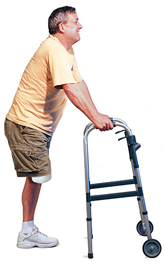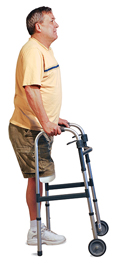Using a Walker After Amputation
As you become mobile again after amputation surgery, you’ll need to use a walking aid to get around. Walking aids help prevent falls, which can seriously damage your wound. At first, you’ll likely use a wheelchair. As your balance improves, you may start using a walker. There are several types of walkers:
-
Standard walkers
-
Front-wheeled walkers
-
4-wheeled walkers
A physical therapist will help select the best walker for you and teach you how to use it safely. Follow all instructions from the physical therapist closely.
Moving forward
-
Stand in the center of the walker frame with your hands on both handgrips. Balance your weight between your intact limb and your hands.
-
Shift your weight slightly back onto your intact limb. Lift or roll the walker forward about 12 inches.
-
Shift your weight onto your hands, pushing down on the handgrips. Move your foot forward to the center of the walker frame. Make sure your toe doesn't go past the front of the walker.
-
Repeat to take your next step.
Note: Don’t step too far inside the walker. Always aim for the center of the frame.
 |
| For safety, keep your hands on the handgrips at all times while using a walker. |

Sitting down
-
Position yourself in front of the chair, keeping your residual limb slightly forward.
-
Be sure the chair is braced so it can’t slide out from under you as you sit.
-
Bend forward at the hip, reaching behind you with 1 hand.
-
Grasp the armrest or side of the chair.
-
Do the same with the other hand.
-
Lower yourself onto the center of the chair, then slide back.
-
To get up, reverse the steps above.
Note: This method can also be used to get into and out of a car.
Moving through doorways
To push open a closed door:
-
Stand facing the doorway with the walker close to the door.
-
Use 1 hand to turn the knob and push the door so it swings open.
-
Then move the walker into the doorway to keep it from closing.
-
Walk through the doorway, using the walker to hold the door open as you pass through.
To pull open a closed door:
-
Stand to the side opposite the direction the door will open.
-
Use 1 hand to turn the knob and pull the door so it swings open.
-
Move the walker into the doorway and keep the walker firmly planted so the door doesn't close.
-
Walk through the doorway. The walker will keep it from closing until you're through.
Note: For safety, never remove both hands from the walker at the same time. Don't use revolving doors when using a walker.
Curbs and steps
Your walker may be used to climb a single step, such as a curb. Before climbing a curb, look for curb cuts. These are places where curbs are cut down to street level. Use curb cuts whenever you can.
To step onto a curb:
-
Place the walker as close as possible to the curb.
-
Step into the center of the frame.
-
Lift the walker onto the curb.
-
Step up and into the frame with your intact leg, pushing down onto the handgrips with your hands.
To go down a curb or step:
-
Place the walker as close to the edge as you safely can.
-
Place your foot close to the edge of the curb.
-
Lower the walker to the street. (Brace the frame against the curb to keep the walker steady.)
-
Holding the handgrips securely, lower your foot down into the center of the frame.
Note: For a person with an amputation, walkers may not be safe for use on stairs. If you can’t prevent taking stairs, ask your physical therapist for special instructions.
Home safety tips
Making a few changes at home can reduce hazards and help prevent falls. Ask a family member or friend to make these changes before you arrive home:
-
Remove objects that could cause you to trip, such as area rugs, thresholds, and loose cords.
-
Store supplies between waist and shoulder level. This will help you maintain balance as you reach for things.
-
Make sure all rooms are well-lit.
-
Move all electrical cords out of the way or tape them securely to the floor.
-
Pick up clutter. Keep floors clear at all times.
-
Prepare a bedroom or sleeping area on the main level if you normally sleep upstairs.